What Are the Main Types of Chatbots for E-Commerce?
Glory-Anna Oshafi
There have been several technological innovations used across various industries over the years to improve customer experience and reduce running costs. Remember the last time you visited an online store and a small window popped up, offering help? That was likely a chatbot. These digital assistants have revolutionized the way many brands, especially e-commerce stores, interact with their customers, ensuring they’re assisted at every step. In fact, a staggering 88% of users had at least one conversation with a chatbot in 2022, highlighting their growing presence and acceptance in the online sphere. In this guide, we’ll detail how chatbots are used in e-commerce and the main types of chatbots suitable for e-commerce stores.

What Are Chatbots?
Chatbots are computer programs designed to act as conversational tools. Chatbots can simulate conversations with customers through natural language processing and artificial intelligence. Based on the received prompt, chatbots offer predefined replies.
Many brands and organizations use chatbots to either support or replace human customer service agents. Chatbots vary in their functionality and performance.
Let’s see why chatbots are important in e-commerce.
Why Are Chatbots Important for E-commerce?
Chatbots perform functions that are vital to the success of many e-commerce stores. A key aspect of e-commerce customer service is providing efficient customer support. E-commerce stores can achieve this by adding chatbots to their customer service strategy.
There’s also the need to provide instant replies to customer inquiries, a need that can be met by using chatbots. Chatbots are also useful for gathering customer data and insights. They are faster and often more efficient than using human customer service agents. This saves time and money for other aspects of the business.
The Role of Chatbots in E-commerce
In e-commerce, chatbots play a dynamic role that benefits both owners and customers. This isn’t just a trend; data from 2022 showed that 88% of users engaged in at least one conversation with a chatbot. Their dynamic role in e-commerce is not only beneficial but also increasingly prevalent, serving both owners and customers alike. Here are the critical roles performed by e-commerce chatbots.

Improving Customer Experience
Customer support is a key part of the customer experience. An improved customer experience is vital to customer retention and brand loyalty. Customers want a prompt response to their inquiries and complaints. Chatbots are efficient as they answer frequently asked questions and other customer inquiries instantly.
Chatbots massively reduce wait times while ensuring accuracy and consistency. Instead of having to speak to multiple human agents, chatbots can provide predefined answers while reducing errors in customer engagement.

Streamlining Sales and Support
Ever abandoned your shopping cart because you couldn’t find an answer to a product-related question? Chatbots are here to change that. By guiding customers, answering queries, and even assisting post-purchase, they’re turning potential lost sales into conversions. Chatbots efficiently take customers through the entire journey while providing personalized product recommendations. This can contribute to upselling and cross-selling, increasing profit for e-commerce store owners.
Chatbots also offer multi-platform integration, ensuring customers can get adequate support at different stages of the sales process. Through chatbots, you can automate interactions to offer step-by-step assistance. Also, chatbots can handle inquiries concerning product returns, shipping delays, and other related inquiries.
Enhancing Personalization and Engagement
Remember when a salesperson remembered your name and preferences during your second visit to a store? It made a difference, didn’t it? In the digital world, chatbots bring that level of personal touch, ensuring every shopper feels unique and valued. It might be difficult for human customer support agents to handle personalization and engagement when it comes to a high number of customers.
However, chatbots can handle these with ease as they can keep conversations and perform dynamic functions. AI-powered chatbots especially provide a deeper level of personalization. They are more interactive and can provide an almost human-like feel to customer support.
Chatbots serve as virtual helpers that keep track of customer preferences and shopping history and offer products that match them. Apart from handling customer inquiries, chatbots can also ask questions during conversations with customers, ensuring they are satisfied with each stage of the sales process.
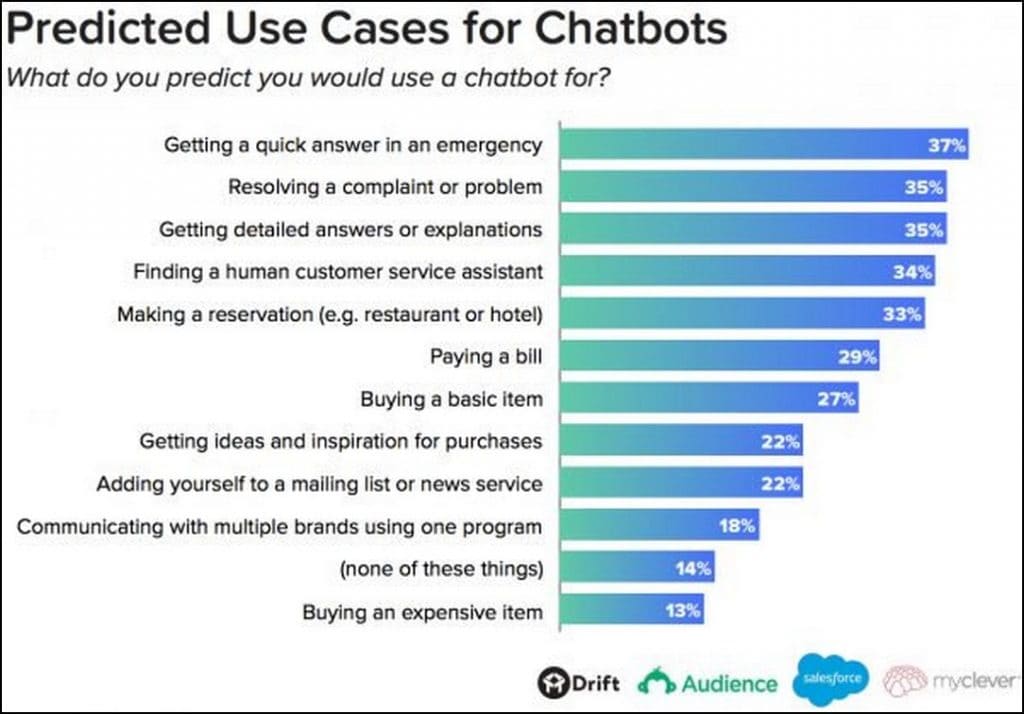
Main Types of Chatbots for E-Commerce
Chatbots come in various types. Some chatbots answer basic questions with predefined responses, while some can handle sophisticated processes and improve customer interactions as they interact more with customers.
Here are the major types of chatbots in e-commerce:
Rule-Based Chatbots: Features and Use Cases
“Let’s take a trip down memory lane. The early pioneers in the chatbot world were the rule-based bots. Simple, yet effective, they paved the way for the advanced bots we interact with today. They’re also known as linguistic-based chatbots. Based on the predefined prompts, rule-based chatbots can respond using an if/then logic.
When a customer asks a question that is connected to the decision tree, the chatbot provides an answer previously specified by the developer. Rule-based chatbots are simple and easy to train.
The rules specified by the developer can be simple or complex, depending on the purpose and the industry field. However, in e-commerce, rule-based chatbots mostly work with simple rules.
Key Features
- Decision Trees
- Easy to set up and deploy
- Predefined responses
- Predefined conversation paths
In e-commerce, rule-based chatbots can be used to handle frequently asked questions, such as shipping inquiries, return policies, product availability, etc. Rule-based chatbots can also be used to offer product recommendations on a basic level. They can be used to gather feedback, promote products, and help with routine transactions.
Self-learning Chatbots: Features and Use Cases
Self-learning or machine-learning chatbots are more advanced than rule-based chatbots. A key feature of self-learning chatbots is the use of Machine Learning to store conversations or prompts from users.
The chatbot then learns from these conversations to improve and further personalize the responses. Self-learning chatbots can handle complex conversations and offer more flexibility than rule-based chatbots.
Key Features
- Machine Learning and Natural Language Processing
- Can handle complex inquiries
- Offers more personalization
- Contextual awareness
Self-learning chatbots are used in e-commerce to handle a wider range of customer inquiries. They can engage in human-like interactions and offer customers personalized assistance and product recommendations.
Based on the gathered information, self-learning chatbots can handle cross-selling and upselling, returns, and feedback analysis.
AI-Powered Chatbots: Features and Use Cases
AI-powered chatbots are widely used due to their sophistication. In recent times, the technology has improved further, making them suitable for use across various industries. AI-powered chatbots use natural language processing technologies and machine learning to understand prompts and interact with customers without human input.

AI chatbots can handle the automation of more questions and can handle complex issues. However, AI chatbots cost more and take more time to train. They can easily mimic human speech and possess more contextual awareness.
Key Features
- Machine learning and natural language processing
- A wide range of support
- Can handle sophisticated queries
- Self-learning
E-commerce stores use AI-powered chatbots to handle a large volume of customer inquiries. AI chatbots offer dynamic functionality. They are used to analyze large amounts of user data to provide product recommendations and advanced customer support. Also, they can process voice commands and handle multilingual support.
Button-Based Chatbots: Features and Use Cases
Button-based chatbots are one of the earlier types that perform basic functions in a simple manner. They display buttons based on a decision tree requiring the customer to choose an option.
Unlike AI-powered chatbots, button-based chatbots do not accept free text input. Instead, the customer can only choose from a set of buttons. eBay has a button-based chatbot that leads the customer to a live representative.
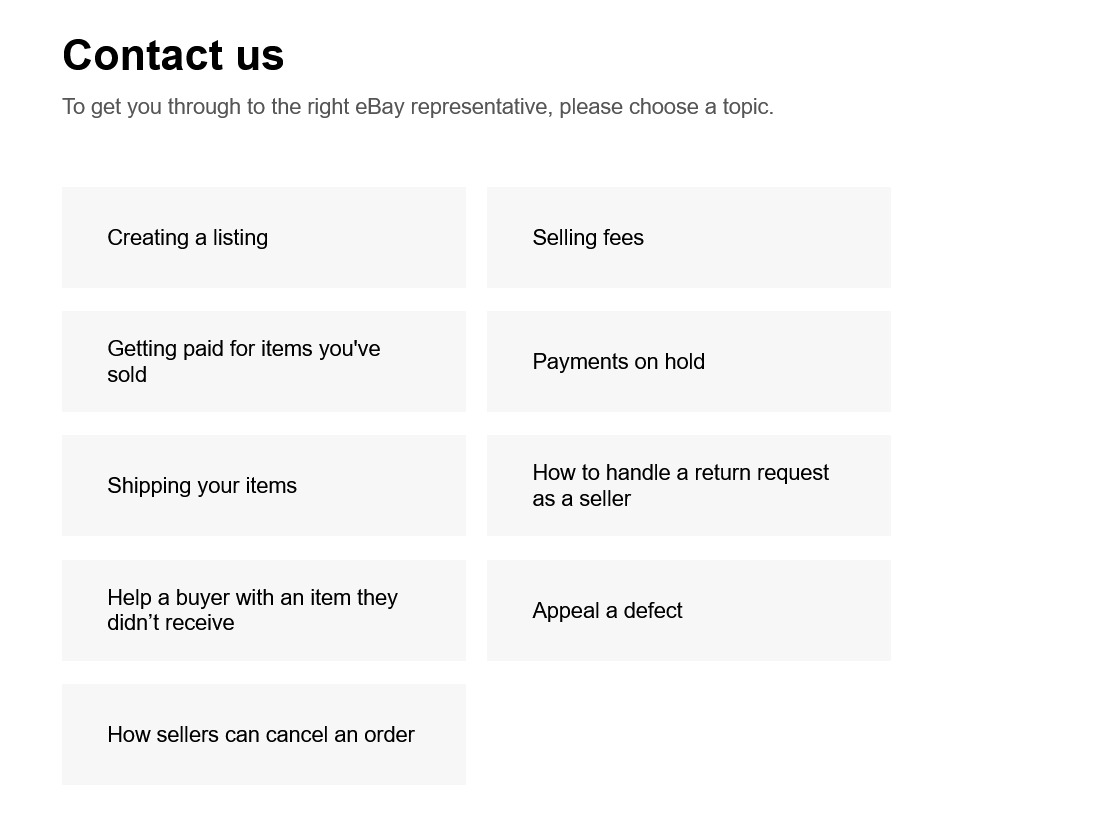
When setting up the bot, the developer inputs the common problems or inquiries from customers and the suitable responses. Button-based chatbots cannot handle complex inquiries.
Key Features
- Simple layout
- Limited user input
- Efficient at handling repetitive inquiries
- Controlled and structured interactions
Button-based chatbots are commonly used for specific scenarios. They can be used to handle a limited set of frequently asked questions, orders, scheduling, and basic troubleshooting.
Hybrid Chatbots: Features and Use Cases
Hybrid chatbots are a common choice for large enterprises with a large customer base. Hybrid chatbots are a combination of two or more types of chatbots. For example, a hybrid chatbot can be a combination of a button-based chatbot and an AI-powered chatbot.
They can handle simple queries as well as complex interactions. When needed, hybrid chatbots can also switch to a live agent. Hybrid chatbots cost more time and funds to set up and train.
Key Features
- Wider support scope
- Can handle both simple and complex tasks
- Adaptable and scalable
Hybrid chatbots are used in large enterprises to handle both complex and simple data. They are also used in the medical field to generate reports based on the patient’s input.
In e-commerce, they can be used to handle personalized recommendations, a wide range of customer inquiries, customer engagement, and more.
Keyword Recognition-Based Chatbots: Features and Use Cases
Keyword recognition-based chatbots offer customer support by analyzing specific keywords in customer text input. Based on these keywords, they offer a tailored response.
These chatbots incorporate Machine Learning, Artificial Intelligence, and Natural Language Processing to a certain degree. They are easy to develop and can portray a level of user intent recognition. Usually, they are combined with button-based chatbots.
Key Features
- Keyword detection
- Easy to set up
- Structured and consistent responses
- Limited context awareness
Keyword recognition-based chatbots are commonly used to handle product inquiries, basic queries, orders, and other functions.
Voice Bots: Features and Use Cases
Lastly, voice bots, as the name suggests, accept voice input from users and can offer a suitable audio response. Voice bots can either be basic, like automated call service assistants, or advanced, such as Alexa, Siri, or Google Assistant.
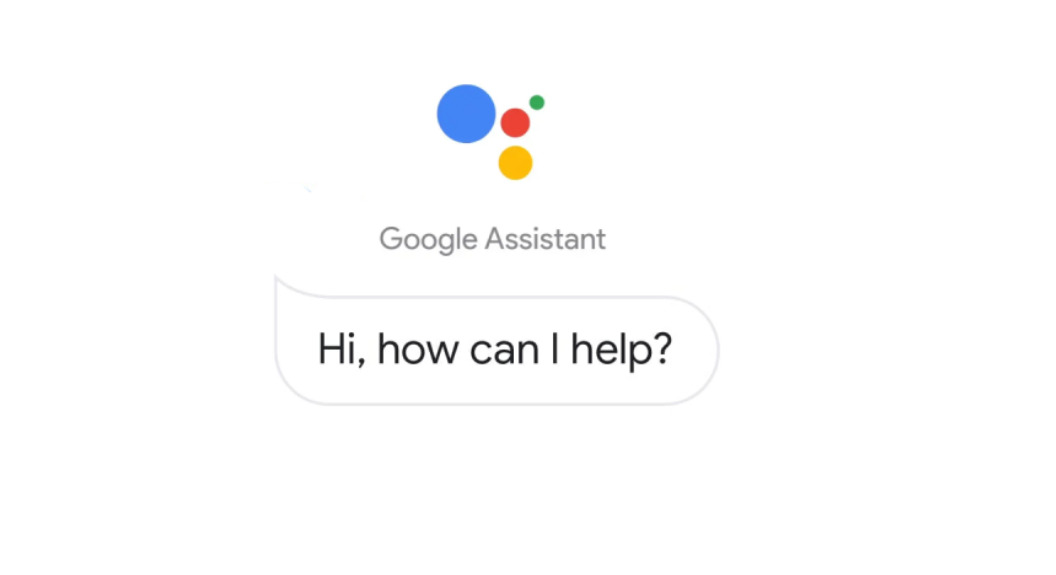
Key Features
- Suitable for various sectors
- Better user engagement
- Speech processing
- Can handle complex communication
Voice bots can handle a wide range of customer inquiries while being user-friendly. They can handle and process orders, complaints, product recommendations, voice searches, etc.
Juphy’s AI Sales Agent for Shopify
Transforming your e-commerce store into a memorable and personalized shopping destination has never been easier, thanks to a range of advanced chatbots. These helpful virtual assistants are designed to enhance the overall customer experience, recreating the in-store atmosphere. Among these, meet Juphy AI – your dedicated ChatGPT-powered Sales Associate for Shopify stores. With its seamless one-click integration to Shopify and requiring no technical skills, Juphy’s AI Agent, featuring the ‘Built for Shopify’ badge, assists you in effortlessly forming a rich and unique shopping journey for your customers.
See how it works:
Instant Assistance
Nothing is like having your questions addressed around the clock during the shopping experience, potentially converting it into a buy. Customers are often impatient when seeking help with products or common queries and desire quick responses day or night. Juphy’s AI Agent for Shopify serves as a constant support point, offering quick responses 24/7, 365 days a year. It ensures consistent and efficient customer service without the need for breaks.
Tailored Shopping Experience
Picture having a personal shopping assistant that not only remembers your preferences, style, and prior purchases but also instantly suggests products according to your tastes. Juphy AI transforms this vision into reality by crafting a personalized shopping journey. Using data like browsing histories, preferences, and past purchases, it seamlessly adds a simple yet highly effective personal touch to your customers’ shopping trips.
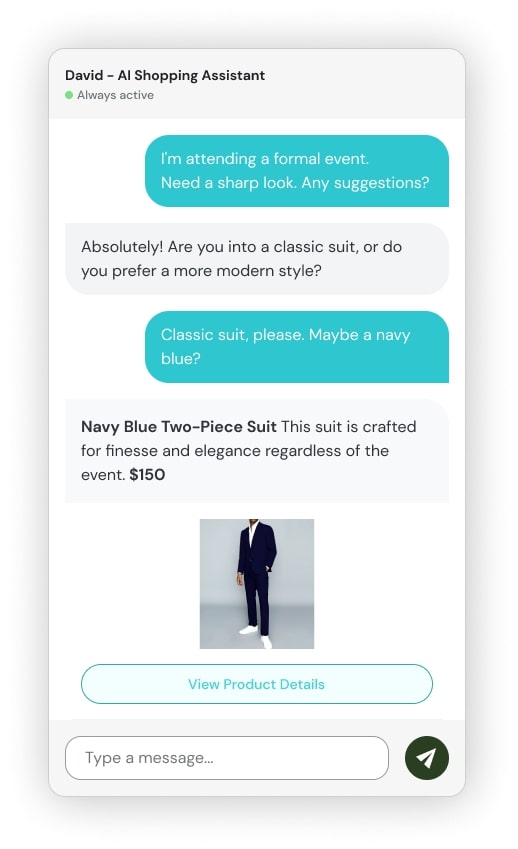
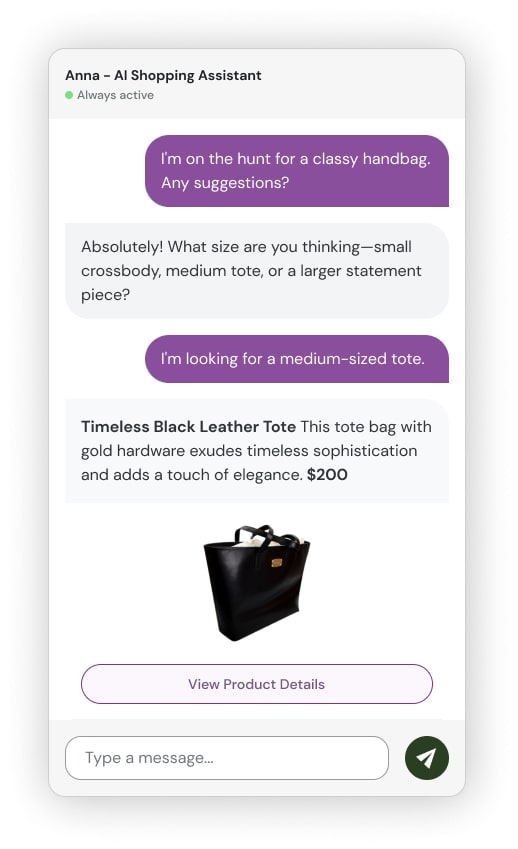
Sales and Support
Exceptional customer support is crucial for a positive customer experience, addressing product inquiries, details, and post-purchase questions. High-quality support forms satisfaction and loyalty among buyers. Juphy’s AI Agent goes beyond providing great support for inquiries about return policies, shipping issues, or product details whenever your customers need it. Moreover, it also excels in driving sales and increasing them by selling even at night.
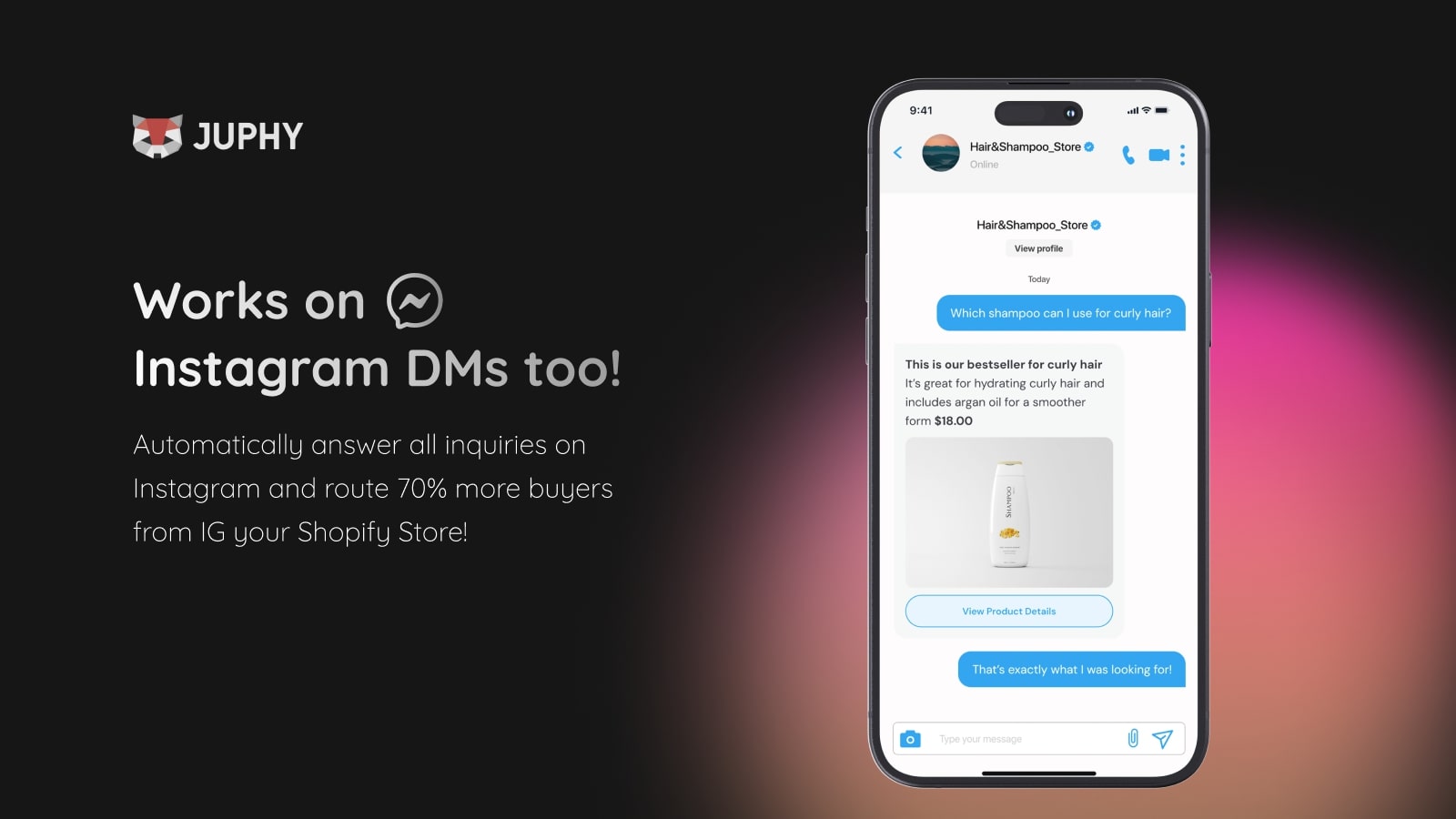
Conclusion
Chatbots offer a wide range of solutions in the e-commerce industry. From button-based to AI-powered, all types of chatbots perform various functions and are perfect for enhancing customer experiences, streamlining sales and support, and engaging customers.
You can choose the one that suits your business and budget the most, and you’ll see the effectiveness in no time.

